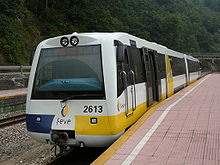Ferrocarriles de Via Estrecha

The numerous Spanish narrow-gauge railways were combined in 1965 in the state-owned company Ferrocarriles de Vía Estrecha (FEVE) ( German narrow-gauge railways ). Its Basque network from Bilbao via Donostia-San Sebastián to Hendaye was handed over to the railway company EuskoTren in 1982 . As of January 1, 2013, FEVE was incorporated into the Renfe Operadora railway company and the ADIF infrastructure operator as part of government austerity measures . Renfe Feve , abbreviated to Feve, has been a trading division of Renfe Operadora since then.
network
The route network of the former FEVE covers around 1,200 km in meter gauge . The main route runs along the north coast of Spain from Bilbao via Santander and Oviedo to Ferrol . It crosses the autonomous communities of the Basque Country , Cantabria , Asturias and Galicia and runs largely parallel to the northern route of the Camino de Santiago , the Camino del Norte . A hotel train called Transcantábrico also runs on this route in summer , which enables holidaymakers to take an eight-day round trip along the Cantabrian Sea.
Another route connects the cities of Bilbao and León , but with only one connection per day and a journey time of over six hours. This line was closed in the 1990s due to technical defects. In 2003 operations were resumed after some renovation measures. (see main article: Ferrocarril de La Robla ) A short route with no connection to the rest of the network in northern Spain exists in the Murcia region between Cartagena and Los Nietos .
In addition to the main lines, there are branch lines in the regions of Cantabria and Asturias that are used for S-Bahn operations, as well as some branch lines to connect industrial sites, mines and ports for freight traffic . Some of these are routes that can no longer be used due to technical deficiencies in passenger traffic.
business
FEVE was a state-owned company and was the operator of local passenger transport and freight transport; the company is now taken over by Renfe. The route network is most popular in the immediate vicinity of the cities of Oviedo and Gijón . There, in the center of Asturias , as well as on the S-Bahn lines of Santander and Bilbao , the network is electrified and partially expanded to include multiple tracks.
passenger traffic
FEVE or Renfe operates S-Bahn lines in the metropolitan areas of Bilbao , Santander , Asturias , León and Ferrol . In León and Ferrol, the network is not electrified and the S-Bahn is operated with diesel trains. On the network sections with S-Bahn operation, trains usually run every quarter of an hour to an hour, depending on requirements. In addition, diesel-powered regional trains run between these centers, with mostly only single connections per day. These only stop at a few, more important stations in the regions with S-Bahn operations. Only railcars are used in regular service. In addition, there are irregular nostalgia and tourist trips, on which very different, mostly locomotive-hauled passenger trains are used. In addition to the Transcantabrico luxury train , special trains run as part of weekend excursions to various sights, whereby the tickets are usually sold as part of package deals that include food and entrance fees. The excursions taking place are advertised on leaflets in the train stations.
Freight transport
The narrow-gauge railway plays an important role in freight traffic in northern Spain. Raw materials extracted from mines in particular are transported to heavy industry for further processing . For the purpose of freight transport, there are also branches in the FEVE network that are not served in passenger transport. The company also enables goods to be transported outside of its own network. The network of the Basque operator EuskoTren is connected to its own network by a transition track in Bilbao. Freight transport to other Spanish regions and abroad is made possible by loading narrow-gauge freight wagons onto freight trains of other gauges using flat-bed wagons. Other narrow-gauge railway companies also use this concept for freight transport.
history


When rail traffic was introduced on the Iberian Peninsula, it was finally decided to use a broad gauge of 1674 mm (from 1955 then 1668 mm) as the standard, in order to ensure a more stable run with wider trains and more goods or people in one train to be able to transport. In addition to all the advantages of the broad-gauge format, disadvantages were also discovered, in particular the difficulty of building a broad-gauge route through mountains and the larger space requirement. As a consequence, several independent narrow-gauge lines were built in Spain parallel to the broad-gauge infrastructure, mostly operated by small private companies. Spain was also affected by the waves of decommissioning in the 1960s and 1970s. The private railway companies were threatened by a wave of bankruptcies. In order to prevent a large part of the rail traffic from being paralyzed by the bankruptcy of the operators, FEVE was initially founded as a state-owned company with the aim of taking over these operators in trust. Unprofitable routes were shut down. In the meantime, however, some narrow-gauge lines have been taken over by regional operating companies and are in a stable condition. These include SFM on Mallorca , EuskoTren in the Basque Country , FGC in Catalonia and FGV in Valencia . The narrow-gauge lines in the greater Madrid area were taken over by the state railway RENFE and, with the exception of line C-9 (formerly Ferrocarril Eléctrico del Guadarrama ) between Cercedilla and Cotos , converted to broad gauge . The Ponferrada - Villablino route in Castile-Leon became the responsibility of the state government and is now only used for the occasional transport of raw materials. Most of the disused routes are still there today, but no longer operational. Whether it is useful to modernize individual routes and resume operations is constantly being investigated and in some cases has also been put into practice. On the other hand, routes that still prove to be unprofitable have been converted into cycle paths as part of the Vías Verdes (green paths) project .
Projects and future
Due to the difficult financial situation in Spain, the railway company FEVE was integrated into the Spanish state railway company RENFE in 2013. Since then, the tracks have been managed by the infrastructure company ADIF. All projects were postponed or abandoned, including projects that had already started implementation.
Dual system light rail in León
In the Spanish city of León it was decided to build a meter-gauge light rail network on which dual-system vehicles can use the existing narrow-gauge route in the vicinity. The construction work began at the beginning of 2011. The railway line was cut about 3 km north of the former end point in order to rededicate the southern section into a light rail line. At the end of March 2014, the Spanish Ministry of Construction announced that this project should no longer be continued. The route should end in the north of the city in the long term, as the rest of the route has already been dismantled. For what purpose the areas of the unfinished light rail construction site will be used in the future remains unclear.
Railway line from Matallana to Vegacevera
In the past there was already a rail connection for the transport of raw materials in the town of Vegacevera. The completely dismantled route with a length of approx. 10 km is to be rebuilt, in particular to transport tourists to Vegacevera. The regional government is planning to set up a center for high alpine tourism here. In addition to other construction projects, new cable cars are to be built into the high mountains here. A realization of the railway line is dependent on the implementation of the overall project, which is uncertain due to the Spanish economic crisis.
S-Bahn tunnel in Gijón between Jovellanos station and the Cabueñes district
In the Spanish region of Asturias, a regional light rail concept is planned, which includes a railway tunnel in the city of Gijón. Although the shell of the tunnel has largely been completed, the tunnel has not been further built since 2006. The maintenance of the unfinished tunnel costs around 100,000 euros annually.
Full electrification between Bilbao and Oviedo
There are electrified island companies in the metropolitan areas of Bilbao, Santander and Asturias. Electrification should be expanded in order to enable electric rail transport between these three regions as well. So far, electrification has only been extended between Infiesto and Ribadesella in Asturias.
Extension of the route from Collanzo to Felechosa
The existing route between Trubia and Collanzo is to be extended by a few kilometers to the town of Felechosa. Construction should be completed in 2012. Implementation had not yet started in March 2014, so that it remains uncertain.
Conversion of the Cartagena - Los Nietos railway line into a light rail system
The isolated railway line between Cartagena and Los Nietos was to be converted into a light rail. Here too, implementation has not yet started.
Former routes
There were narrow-gauge lines in all parts of the country that have been closed in recent decades. Some routes have been dismantled or converted into cycle paths - other routes are still there. Most of the land is still owned by the company. Based on studies that see the rehabilitation and reactivation of individual routes as a positive cost-benefit factor, political proposals have been submitted to reactivate one or the other disused route.
Various narrow-gauge railways were transferred to the company in the 1970s, but these were only continued for a very short period of time, as they were mostly isolated routes for which the expense of an individual operation was not worthwhile. The following table shows a selection of routes on which FEVE was the last operator:
| Route | region | current condition |
|---|---|---|
| Malaga - Coin | Andalusia | Bike path |
| Málaga - Fuengirola | Andalusia | converted to broad gauge and taken over by RENFE |
| Arriondas - Covadonga | Asturias | is being prepared for museum operation with steam trains |
| Calahorra - Arnedo | La Rioja | Bike path |
| Haro - Ezcaray | La Rioja | Bike path |
Web links
- FEVE (Spanish)
- Ferrocarriles de Vía Estrecha, Parque Motor in the Spanish-speaking Ferropedia
- German information about the "Transcantabrico" hotel train
- Report on the S-Bahn tunnel in Gijón (Spanish)
- Report on the future tunnel in Bilbao (Spanish)
- discontinued lines ( Memento from June 30, 2008 in the Internet Archive ) (Spanish)
Individual evidence
- ↑ Ferrocarriles de Vía Estrecha: El Transcantábrico. Retrieved April 20, 2012 (Spanish, English).
- ↑ The modernization of the Basque Railways is progressing slowly in: Stadtverkehr 3/1982, p. 106 ff.
- ↑ http://leonoticias.com/frontend/leonoticias/Fomento-Anula-La-Integracion-De-Feve-Al-No-Existir-garantia-vn140301-vst216
- ↑ http://www.diariodeleon.es/noticias/afondo/tren-vegacervera-espera-veredicto-ambiental-junta-iniciar-obra_625427.html
- ↑ Archive link ( Memento of the original from April 7, 2014 in the Internet Archive ) Info: The archive link was inserted automatically and has not yet been checked. Please check the original and archive link according to the instructions and then remove this notice.
- ↑ http://www.elcomercio.es/v/20121013/gijon/mantener-tunel-metrotren-costara-20121013.html
- ↑ http://archivo.lavozdeasturias.es/html/488790.html ( page no longer available , search in web archives ) Info: The link was automatically marked as defective. Please check the link according to the instructions and then remove this notice.
- ↑ http://www.lne.es/cuencas/2009/07/16/feve-dispondra-proyecto-llevar-tren-felechosa-plazo-18-meses/782792.html
- ↑ Archive link ( Memento of the original dated August 9, 2011 in the Internet Archive ) Info: The archive link was inserted automatically and has not yet been checked. Please check the original and archive link according to the instructions and then remove this notice.






